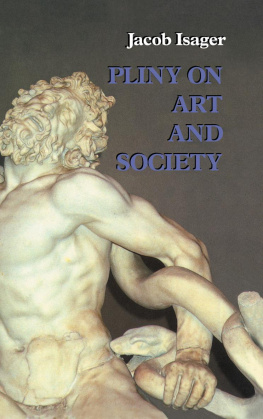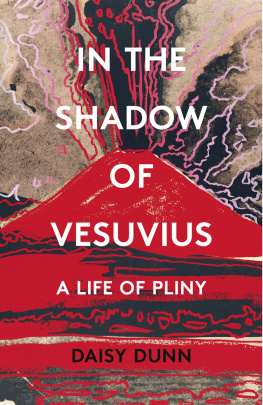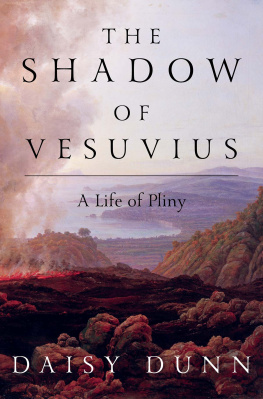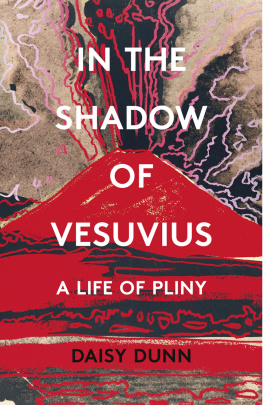First published 1991
by Routledge
2 Park Square, Milton Park, Abingdon, Oxon, OX14 4RN
Simultaneously published in the USA and Canada
by Routledge
a division of Routledge, Taylor & Francis
270 Madison Ave, New York NY 10016
Transferred to Digital Printing 2006
Jacob Isager 1991
Translation by Henrik Rosenmeier
All rights reserved. No part of this book may be reprinted or reproduced or utilized in any form or by any electronic, mechanical, or other means, now known or hereafter invented, including photocopying and recording, or in any information storage or retrieval system, without permission in writing from the publishers.
British Library Cataloguing in Publication Data
is available
Library of Congress Cataloguing in Publication Data
is available
ISBN 0-415-06950-5
Publisher's Note
The publisher has gone to great lengths to ensure the quality of this reprint but points out that some imperfections in the original may be apparent
Preface
My interest in the Elder Pliny dates from my undergraduate days. Over the years my work on the text has taken me far afield, and my debt of gratitude to institutions and persons is accordingly great.
In addition to Odense University, whose support of my research has been unstinting and always readily available, I wish to thank the staff at The Danish Academy in Rome, especially Karen Ascani, for their untiring assistance in matters scholarly and practical.
Among the many colleagues at home and abroad who have offered considerable help in the process of my work, I wish in particular to thank Jesper Carlsen, Margrete Hahn, Niels Hannestad, Mogens Leisner-jensen, Mette Moltesen, Birte Poulsen, Jens Erik Skydsgaard and Jan Zahle.
Three persons have offered highly constructive criticism of the final versions of the manuscript. They are Patrick Kragelund, Fritz Saaby Pedersen, and my wife Signe Isager.
Warm thanks are due to my translator Henrik Rosenmeier who not only saw to the difficult task of turning my Danish into English, but also contributed to the clarity and comprehensibility of the text.
For helping me prepare the manuscript for the press I wish to thank Humanistisk Skrivestue at Odense University and Susanne Httel, secretary at the Department of Classical Studies. Always ready with advice she has patiently and competently solved many, often acute, word-processing problems.
Finally, I wish to express my deep gratitude to Ingenir N. M. Knudsens Fond, Odense and Statens Humanistiske Forskningsrd for their economic support of the translation and the printing, and Odense University Press and Routledge, London, for the publication of the book.
Jacob Isager
In his books on mineralogy in the Natural History the Elder Pliny presents a review of Greek artists and works of art and of Roman art in the form of digressions. Art work in precious metals is discussed in Book 33, while bronze art and painting are included in Books 34 and 35. Amongst other subjects of Book 36 is marble, and here its uses in art and architecture are also discussed. Precious stones are dealt with in Book 37. These sections constitute the sole art historical material from antiquity left to us, all that remains of an extensive literature that dealt with art and art history.
During the Middle Ages.
From an art historical point of view the Elder Pliny does not begin to be of interest until we come to Petrarch In 1476 appeared the first Italian translation by Landino and by 1543 six reprintings had seen the light of day.
Pliny's chapters on art maintained their position as one basis for art history all the way until about 1800, when his text served, for example, as the basis for Professor Torkel Baden's lectures at the University of Copenhagen on the general history of art. Winckclmann occasioned a proper systematization of the art of antiquity based on the monuments that had been preserved, and a more critical attitude to Pliny as a source was adopted. In a letter from 1802 to Goethe Schiller voices the then current attitude, which was to prevail well into the twentieth century:
Ich habe in diesen Tagen einige Notizen ber den lteren Plinius gelesen, die mich in Rcksicht auf das, was der Mensch aus einer guten Anwendung seiner Zeit machen kann, in Erstaunen gesetzt haben. Gegen einen solchen Mensch war selbst Haller noch ein Zeitverschwender. Aber ich frchte, er hatte iiber dem ungeheuren Exzerpieren und Diktieren zum freien Nachdenken nicht die rechte Zeit.
The critical attitude to Pliny's information in the entire Natural History had increased during the eighteenth century as the new natural sciences advanced. They must necessarily demonstrate the "erroneous" understanding on the part of the ancients. The texts from antiquity lost authority and a historical distance was adopted. This especially affected works like so to speak.
To this must be added that the efforts to establish a usable text on solid textual principles made it apparent how difficult accessibility to the text was. There are more than 200 manuscripts, most of them without any special interest when it comes to establishing a proper text. A small group of manuscripts from the 10th and 11th century constitutes the basis for the modern editions. The two main problems with these editions are the strong contamination in transmission ot texts and the fact that this is a detailed work about the wonders of Nature frequently presented in very contracted form where it is difficult or impossible to find support for better comprehension in other texts, because there are no other texts to compare with. The majority of the texts from which Pliny gets his information have been lost, and accordingly we have little or no possibility of checking his information. There is, for example, a special problem in his descriptions of certain buildings and the materials used in their construction in Book 36. In some cases the models are preserved and we can compare Pliny with his source, but elsewhere such extreme contractions are employed that Pliny's text becomes incomprehensible at least for the modern reader.
Still, from 1831 and roughly to about 1900, several editions of the text, must receive special credit for having given a new and sensible direction to the excesses of Quellenkritik.
The art-historical chapters were also dissected in this manner in countless articles that appeared in the years before 1900. In 1896 the first "modern" commentary on the art-historical chapters appeared. This was an extensively used and now reprinted edition of the text, furnished with a translation and commentary by K. Jex-Blake and E. Sellers [Strong]. In the introduction there is a survey of the sources seen in the light of most recent scholarship, including Mnzer's. seems to have emerged. In the years between the two World Wars there were no particularly notable scholarly contributions to our understanding of the chapters on art. This was the case with the Natural History as a whole, if we are to judge by Harold L. Axtell who in 1926 speaks despondently about the state of affairs in America (matters were similar in Europe):
Sad is the present fate of Gaius Plinius Secundus. After all his tireless efforts to acquaint mankind with the wonders of the world, ungrateful posterity in the twentieth century, even the lovers of the veteres, has all but forgotten him. Nobody cares to contribute a volume on "Pliny and His Influence", or to annotate his work, or even to constitute a reliable text for it. No university offers a course in it and no classical reading circle includes it in its program. Except as an old worked-over mine to dig in at odd times for the extraction of curious information with which to complete the treatment of some special topic, the Naturalis Historia is not glanced at. And after students take a look at the man himself through the eyes of his nephew, they do not look again, despite the old scholar's heroism














